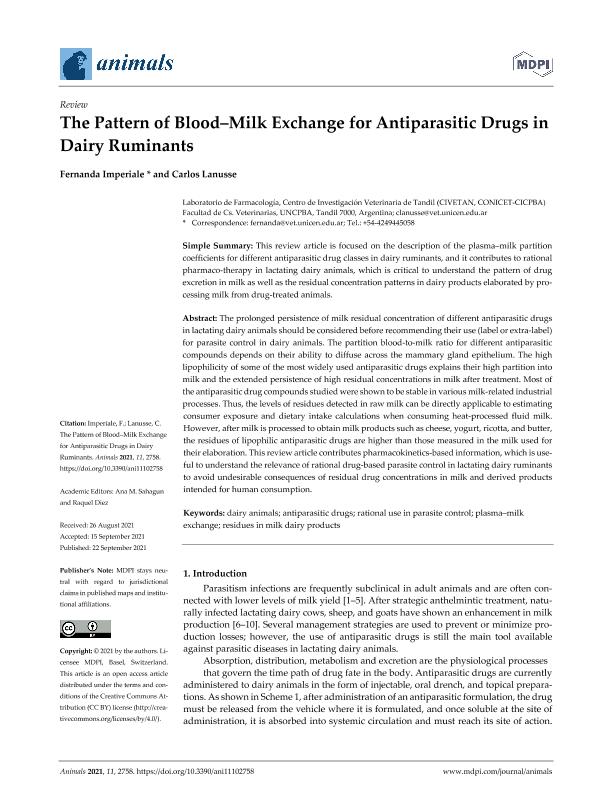Mostrar el registro sencillo del ítem
dc.contributor.author
Imperiale, Fernanda Andrea

dc.contributor.author
Lanusse, Carlos Edmundo

dc.date.available
2023-07-17T14:34:57Z
dc.date.issued
2021-10
dc.identifier.citation
Imperiale, Fernanda Andrea; Lanusse, Carlos Edmundo; The pattern of blood–milk exchange for antiparasitic drugs in dairy ruminants; Multidisciplinary Digital Publishing Institute; Animals; 11; 10; 10-2021; 1-21
dc.identifier.issn
2076-2615
dc.identifier.uri
http://hdl.handle.net/11336/204166
dc.description.abstract
The prolonged persistence of milk residual concentration of different antiparasitic drugs in lactating dairy animals should be considered before recommending their use (label or extra‐label) for parasite control in dairy animals. The partition blood‐to‐milk ratio for different antiparasitic compounds depends on their ability to diffuse across the mammary gland epithelium. The high lipophilicity of some of the most widely used antiparasitic drugs explains their high partition into milk and the extended persistence of high residual concentrations in milk after treatment. Most of the antiparasitic drug compounds studied were shown to be stable in various milk‐related industrial processes. Thus, the levels of residues detected in raw milk can be directly applicable to estimating consumer exposure and dietary intake calculations when consuming heat‐processed fluid milk. However, after milk is processed to obtain milk products such as cheese, yogurt, ricotta, and butter, the residues of lipophilic antiparasitic drugs are higher than those measured in the milk used for their elaboration. This review article contributes pharmacokinetics‐based information, which is use-ful to understand the relevance of rational drug‐based parasite control in lactating dairy ruminants to avoid undesirable consequences of residual drug concentrations in milk and derived products intended for human consumption.
dc.format
application/pdf
dc.language.iso
eng
dc.publisher
Multidisciplinary Digital Publishing Institute

dc.rights
info:eu-repo/semantics/openAccess
dc.rights.uri
https://creativecommons.org/licenses/by/2.5/ar/
dc.subject
ANTIPARASITIC DRUGS
dc.subject
DAIRY ANIMALS
dc.subject
PLASMA–MILK EXCHANGE
dc.subject
RATIONAL USE IN PARASITE CONTROL
dc.subject
RESIDUES IN MILK DAIRY PRODUCTS
dc.subject.classification
Otras Ciencias Veterinarias

dc.subject.classification
Ciencias Veterinarias

dc.subject.classification
CIENCIAS AGRÍCOLAS

dc.title
The pattern of blood–milk exchange for antiparasitic drugs in dairy ruminants
dc.type
info:eu-repo/semantics/article
dc.type
info:ar-repo/semantics/artículo
dc.type
info:eu-repo/semantics/publishedVersion
dc.date.updated
2023-06-28T15:27:11Z
dc.journal.volume
11
dc.journal.number
10
dc.journal.pagination
1-21
dc.journal.pais
Suiza

dc.journal.ciudad
Basilea
dc.description.fil
Fil: Imperiale, Fernanda Andrea. Consejo Nacional de Investigaciones Científicas y Técnicas. Centro Científico Tecnológico Conicet - Tandil. Centro de Investigación Veterinaria de Tandil. Universidad Nacional del Centro de la Provincia de Buenos Aires. Centro de Investigación Veterinaria de Tandil. Provincia de Buenos Aires. Gobernación. Comision de Investigaciones Científicas. Centro de Investigación Veterinaria de Tandil; Argentina
dc.description.fil
Fil: Lanusse, Carlos Edmundo. Consejo Nacional de Investigaciones Científicas y Técnicas. Centro Científico Tecnológico Conicet - Tandil. Centro de Investigación Veterinaria de Tandil. Universidad Nacional del Centro de la Provincia de Buenos Aires. Centro de Investigación Veterinaria de Tandil. Provincia de Buenos Aires. Gobernación. Comision de Investigaciones Científicas. Centro de Investigación Veterinaria de Tandil; Argentina
dc.journal.title
Animals

dc.relation.alternativeid
info:eu-repo/semantics/altIdentifier/url/https://www.mdpi.com/2076-2615/11/10/2758
dc.relation.alternativeid
info:eu-repo/semantics/altIdentifier/doi/http://dx.doi.org/10.3390/ani11102758
Archivos asociados
